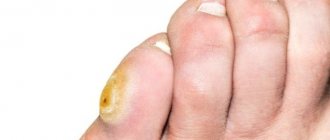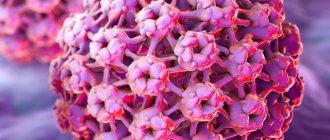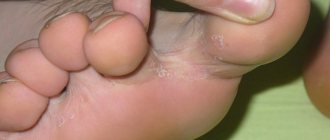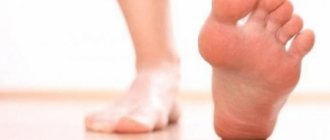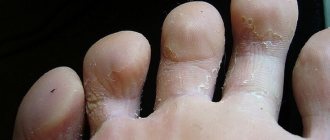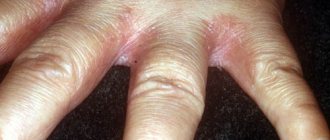In general, in the surgical community there is little talk about calluses and their treatment. Another thing: talk about methods of gastric resection and techniques for suturing the duodenal stump! It's true! And here's something small. Go to the bathhouse, take a steam bath, take a pumice stone, wipe off the callus and everything will go away. But no... It won’t always help.
Calluses are commonly called characteristic changes in the area of skin friction. The skin adapts to prolonged physical exposure, the epidermis becomes thicker. This is a normal physiological process. It is worth working in the country with a hammer for several days to see characteristic thickenings on the palms. This is how the skin adapts. Most of all, it is prone to such protective keratinization of the skin in the area of the soles. And in principle this is obvious. In the distant past, our ancestors did not know shoes, and modern people absolutely cannot imagine walking barefoot, say, through a forest or field. However, as studies have shown, two weeks are enough for the skin on the feet to become rough and walking barefoot will be quite comfortable and not painful.
Why do calluses appear on feet?
Corns between the toes can appear for a variety of reasons. For proper treatment, it is necessary to understand what causes its formation, since the correctness of the chosen strategy depends on this factor. The main reasons for the appearance of formations are considered to be:
- wrong choice of shoes;
- deformation of toes;
- fungal diseases of the foot;
- joint diseases;
- being overweight;
- diseases of the cardiac or urinary system, which lead to the effect of swelling of the limbs.
The main cause of calluses is considered to be wearing unsuitable shoes . This may be due to the inconvenience of the model itself, the quality of its manufacture, or an incorrectly selected size. Such errors cause incorrect distribution of the total body weight on the feet. As a result, some areas of the skin are constantly under stress, and when rubbed against shoes, they show signs of irritation. The body's natural reaction is to try to protect the skin of the feet in areas of increased discomfort. The skin begins to thicken and become denser due to the keratinization of the surface layer of cells.
A painful lump between the fingers appears as a result of friction between them. Their appearance is due to the fact that the skin in such places is very thin and delicate, so it quickly becomes irritated and injured at the slightest inconvenience. The danger is that such wet calluses in the form of white bubbles can burst, opening up access to infection. In this regard, it is necessary to get rid of and treat any interdigital formations, even if they do not cause inconvenience.
When should you contact a specialist?
If all folk and home methods of therapy do not give the desired result, then you need to consult a specialist. The problem of calluses is dealt with by cosmetologists, dermatologists, surgeons and podologists .
Only an experienced doctor can help solve the problem without consequences. He will disinfect the growth and prescribe you the necessary therapeutic course.
If the growth contains pus, a course of antibiotic treatment may be necessary.
If the infection is serious, the doctor will prescribe medications to the patient for oral administration, as well as means for external treatment of the defect (in the form of ointments, creams, gels, etc.).
Dry calluses between the fingers can seriously complicate a person’s life. So there is no point in postponing treatment for such a problem, especially since delay can lead to the formation of complications in the form of rod growths. And this means additional expenses for hardware treatment.
Main varieties
Calluses can be of several types , each of which has a number of distinctive features. Determining whether a callosal formation belongs to a certain type will allow you to choose the right methods and methods of treatment, since they differ depending on the nature of the formation. Types of calluses on feet:
- wet - the first sign of such a callus is the appearance of a bubble filled with liquid;
- dry - is a roughened area of skin, often having a cone-shaped shape;
- dry formation with a rod - is a small spur, there is a round hole inside the seal.
The appearance of any type of formation is always associated with unpleasant pain. The most difficult to treat are dry spurs with a core. An important point is to have full confidence that the formation is truly a callus and is not caused by a viral or fungal infection. Only in this case can you try to remove it. It is often mistaken for a plantar wart, in which case such actions can lead to the spread of the virus and the appearance of numerous new formations.
Preventive measures
To ensure that calluses never bother you again, you need to adhere to the following recommendations:
- carefully monitor foot hygiene;
- use softening ointments, gels, creams, make foot baths;
- give up uncomfortable and low-quality shoes;
- limit wearing high-heeled shoes;
- at the first symptoms of callus formation, immediately begin treatment;
- Do not allow shoe insoles to become thin or curled.
Treatment of wet callus
Many people make a serious mistake when, when a watery soft bubble appears, they try to immediately pierce it. This action can lead to infection, resulting in inflammatory processes.
When a wet callus forms, it is necessary to wash the affected area of the skin and treat it with antibacterial agents. After disinfection, it is necessary to apply a special patch or bandage. It is necessary that the affected area of skin does not come into contact with shoes. After some time, the bubble will open on its own, and the water will pour out, the callus will dry out and stop hurting. At this point it can be easily removed with a pumice stone.
Consequences of improper treatment at home
Incorrect or untimely treatment of calluses (especially in the presence of rod seals) can lead to serious complications. As the defect develops, the patient may experience:
- microcracks;
- infectious infection through formed wounds;
- development of the inflammatory process;
- suppuration.
Defects with pus should be treated only in a hospital setting. This is the only way to get rid of them completely.
Ways to remove dry callus
The difficulty in treating dry calluses is that it is necessary to soften it so that it can be easily removed using pumice or a special device with a peeling effect. You should not use scissors or blades to remove calluses, as such tools can easily cause injury and infection. A good effect in softening calluses is achieved by using baths with herbal infusions . You can use soda or ammonia to prepare the solution.
People with diabetes and blood clotting problems should approach the removal process with caution. In case of large calluses, it is recommended to contact a dermatologist or a specialized clinic for removal.
After mechanical removal of rough skin, it is necessary to apply a compress with a healing or softening effect to the sore spot. Castor oil, sunflower oil, special medicinal ointments or creams are well suited as such remedies.
A good preventative measure to prevent the appearance of calluses is the regular application of creams with a softening effect . An effective and inexpensive product ideal for such purposes is a regular baby cream. The product should be applied only at night, and during the day, use baby powder or talcum powder to prevent chafing of the feet.
What not to do?
If you are going to treat dry calluses yourself, then avoid the following manipulations:
- Do not try to cut off a growth that has not softened, especially if it has a shaft.
- Do not use salicylic acid and vinegar on healthy areas of the skin.
- One callus should only be removed using one specific method.
Important! If you hesitate and cannot decide on a course of treatment, then consult a dermatologist. He will tell you which method is best to use.
Effective recipes for baths
You can get rid of calluses between your toes by using warm foot baths with medicinal solutions. Using warm foot baths is considered one of the most effective and inexpensive methods. Special formulations help to greatly soften the rough skin of the feet, after which removing it from the surface is not difficult.
The following bath recipes are popular:
- Bath with soda and soap - take 800 ml of warm water, dissolve 1 large spoon of soda, soap your feet with laundry soap and place in a container with water.
- Salt bath with cool water to reduce pain - prepare 1 liter of water, dissolve 1 large spoon of coarse salt, place your feet in the bath.
- A bath with potassium permanganate is a product with an antibacterial effect, for the preparation of which you need to dissolve manganese in water until it turns pale pink, add a pinch of salt.
The procedure using any of the listed solutions should last from 15 to 20 minutes. After achieving the effect of softening the callus, it is necessary to carefully remove the surface layer of skin.
Reasons for the formation of callus
Calluses can appear as a result of the following reasons:
- wearing shoes of the wrong size (usually smaller than the true size);
- walking barefoot for a long time;
- wearing shoes with high heels or, conversely, shoes with flat soles;
- constant mechanical irritation of the skin associated with physical work;
In addition, a callus can be the result of a corn, which appears due to constant mechanical pressure on the skin.
Traditional medicine
Traditional medicine recipes do an excellent job of combating the consequences of rough skin and effectively fight calluses, while requiring virtually no cost. It is recommended to try one of the following types of compresses:
- onion based;
- from vodka;
- from garlic tincture;
- based on propolis;
- using vinegar.
Onions and garlic have bactericidal and anti-inflammatory effects, so they are considered excellent ingredients for making compresses for calluses. The compress can be made from onion peels. To do this, you need to collect the required amount of husk, place it in a container and fill the raw material with ordinary vinegar. The material must be kept in a dark room for two weeks. After this, all the liquid is drained, and such a product can be applied along with the patch.
Prevention Tips
You can avoid the occurrence of interdigital calluses if you find the cause of its formation. New shoes often cause foot chafing. But you can prevent such situations and ensure foot hygiene. Thanks to this, skin growths will no longer be a constant companion of a person.
First of all, you should pay attention to the choice of quality shoes and boots . You should choose models made from the most natural materials, as well as those that correspond to the fullness and size of your feet. It is ideal if there is a built-in instep support inside. The heel should be considered not as a decorative element, but as a means to support the foot. At the same time, you should not think that you should completely abandon hairpins. It's just recommended not to wear them every day. Even the few hours a woman wears them can affect the condition of her feet.
At the same time, comfortable sneakers and sneakers also cannot be worn on a regular basis. The ideal model should have a hard sole. If you have any problems with your feet, it is better to use insoles. They are made on an individual basis. There are also special silica gel insoles that are placed between the toes. This is a great tool for preventing friction. Hygiene is also important. If you take proper care of your feet, you will be able to avoid sweating and the likelihood of getting fungal infections.
Last but not least is the general state of health . It is necessary to maintain a healthy weight, eat foods rich in vitamins and especially collagen, as it strengthens ligaments. Diabetics need to constantly monitor their blood sugar levels.
If the pressure forms on an ongoing basis, then this is a reason to consult an orthopedist. He will select special orthopedic insoles that will prevent growths from appearing again.
Treatment of core calluses between the toes
Those who did not pay attention to dry calluses immediately after they appeared, subsequently very often wonder how to cure a callus between the toes with a core. After all, this type is an advanced form of dry callus, inside of which a “root” has formed that goes deep into the skin. This is a very unpleasant formation, since it is characterized by severe pain, as with the appearance of a spur, especially if the rod has penetrated to the level where the nerve endings are located.
How to remove this type of callus and can it be done at home? The callus can be removed independently, but only if it is not too deep. However, a positive result cannot always be achieved. The best option for deciding what to do in such cases is to turn to professionals. For this purpose, the medical institution uses:
- Laser burning.
- Freezing using liquid nitrogen.
- Mechanical drilling.
People prone to the appearance of interdigital formations should immediately take measures to eliminate them. After all, in the early stages you can get rid of the callus yourself. But solving the problem of advanced cases will require much more time, effort and money.
How to cure dry and root types?
Root callus is considered a type of dry callus, but it is much more difficult to remove. If the callus is dry, just steam your foot and apply a compress of ointment and salicylic acid.
After a few sessions, the dead skin can be removed. You won’t be able to remove root callus on your own. It has a rod that penetrates into the deep layers of the skin. Therefore, it is better to get rid of this neoplasm in a cosmetologist’s office.
Diagnosis and treatment
It is not recommended to independently treat calluses on the little finger . Despite the fact that most tumors do appear due to uncomfortable shoes, it is better to consult a doctor to rule out other pathological factors.
Diagnostics is carried out in several stages:
- Taking an anamnesis: the doctor asks the patient how long ago the callus appeared, what lifestyle the patient leads, and what additional symptoms are observed.
- Initial examination: the doctor determines the general condition of the skin, determines the type of callus and the degree of its pain.
- Additional examinations: if there is a need to determine the presence of infection, a scraping is taken from the callus. To determine the fungus, a Wood's lamp is used, and general tests are prescribed to exclude hidden pathologies.
How to remove it from pharmaceutical products?
Based on the data obtained, treatment is prescribed to the patient. Therapy depends on the type of tumor and its neglect.
- To remove dry calluses or corns, place the foot in warm water for 10 minutes. The rough skin is carefully removed with a pumice stone or a foot file. Then apply a cream with salicylic acid, urea or ammonium lactate to soften.
- Wet calluses go away on their own within a week. The main thing is that the affected area does not rub against the shoes. The blister is not opened, but covered with a clean, dry bandage.
- Calluses are usually removed in a beauty salon. The keratinized tissue is drilled out with a special thin drill, and a therapeutic bandage is applied to the area, which will prevent the rod from forming again.
Attention! Typically, salicylic acid-based patches and ointments are used to treat calluses. In difficult cases, laser or liquid nitrogen removal is used.
